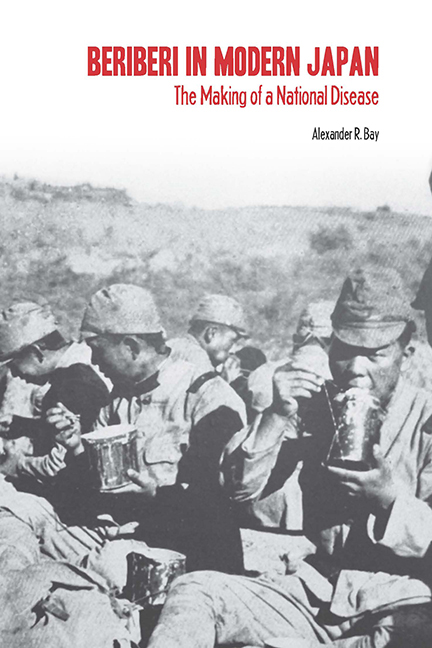Book contents
- Frontmatter
- Dedication
- Contents
- List of Illustrations
- Acknowledgments
- Introduction: Medicine, Power, and the Rhetoric of Empire
- 1 The Geography of Affliction: Beriberi in Edo and Tokyo
- 2 Putting the Laboratory at the Center
- 3 Beriberi: Disease of Imperial Culture
- 4 Empire and the Making of a National Disease
- 5 The Science of Vitamins and the Construction of Ignorance
- 6 The Rice Germ Debate: Total Mobilization and the Science of Vitamins in the 1930s
- Conclusion
- Notes
- Bibliography
- Index
1 - The Geography of Affliction: Beriberi in Edo and Tokyo
Published online by Cambridge University Press: 08 April 2017
- Frontmatter
- Dedication
- Contents
- List of Illustrations
- Acknowledgments
- Introduction: Medicine, Power, and the Rhetoric of Empire
- 1 The Geography of Affliction: Beriberi in Edo and Tokyo
- 2 Putting the Laboratory at the Center
- 3 Beriberi: Disease of Imperial Culture
- 4 Empire and the Making of a National Disease
- 5 The Science of Vitamins and the Construction of Ignorance
- 6 The Rice Germ Debate: Total Mobilization and the Science of Vitamins in the 1930s
- Conclusion
- Notes
- Bibliography
- Index
Summary
In 1549, the priests of Kyoto's Uzumasa Kōryūji petitioned the gods during the Ox Festival to relieve their suffering that was caused by a myriad of ailments such as colic, sore throats, coughing, respiratory congestion, carbuncles, boils, tumors, chapped and cracked skin, runny noses, diarrhea and bloody stools, morning sickness, and swollen testicles. Medieval sources like the Uzumasa Kōryūji petition and the Yamai no sōshi (Scrolls of affliction) suggest that illness, based on internal imbalances, was understood as a manifestation of outward symptoms affecting certain body parts. By the middle of the Edo period, disease had been reordered, afflicting not only specific places on the body but also new temporal and spatial cartographies. In Sejikenbun mokuroku (Record of worldly things seen and heard), for example, Buyō Inshi wrote that many new diseases stemmed from the era of great peace (taihei no yo). The Confucian scholar Hayashi Jussai noted that many afflictions were a product of the times (kinsei no koto nari). Time, the era of great peace, was pathological; gluttony, leisure, and sexual indulgences all adversely affected the people's health. Specific illnesses were also arranged within a new spatial matrix: the urban cities of Edo (renamed Tokyo in 1868), Kyoto, and Osaka became centers for disease.
The pathology of geography, in the form of the illnesses that awaited those who traveled to distant cities, was important to the identities of large urban centers. In the early modern era, the Tokugawa shogunate, as a part of state-making, carried out new exercises in mapping the archipelago to better identify, order, and control the realm. Marcia Yonemoto argues that commercial maps, to the contrary, were less about control and instead oriented toward detailing local culture and politics. In short, commercial maps were used to chart local identities. I suggest that we include locale identities in this process as well. Medical mapping—what I call the “geography of affliction”—was a process whereby doctors and laymen described new diseases and then mapped them onto the early modern archipelago.
In this chapter, I focus on one place-specific disease—Edo wazurai, the affliction of Edo. Modern science suggests that Edo wazurai (also called kakke) was beriberi. I examine medical discourse and practice concerning beriberi with a special focus on the role of environment and locale in disease causation. I also explore the development of Western medicine during the early Meiji period.
- Type
- Chapter
- Information
- Beriberi in Modern JapanThe Making of a National Disease, pp. 11 - 29Publisher: Boydell & BrewerPrint publication year: 2012

